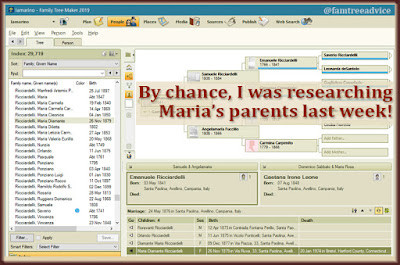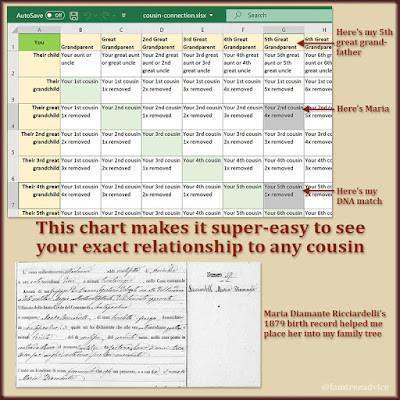Have you ever felt lost in the labyrinth of family relationships, especially when DNA testing reveals a network of cousins you never knew existed? Like many genealogy enthusiasts, I recently found myself in this exact situation after uncovering hundreds of potential cousins from my ancestral town of Santa Paolina, Italy. Sifting through countless vital records from 1809–1945 was just the beginning. The real challenge was understanding how these newfound relatives connected to me and to each other. This is where the concept of a Cousin Family Chart becomes invaluable.
To bridge the gap between historical records and living relatives, I turned to AncestryDNA. The platform’s filtering tools are excellent for narrowing down matches. By focusing on specific surnames linked to Santa Paolina, I could pinpoint individuals with those names in their family trees, even private ones.
Finding a Likely Cousin Connection Through DNA
I decided to explore the surname Ricciardelli, a common name in my ancestral town. Filtering my AncestryDNA matches for this surname, I selected a match in the 4th–6th cousin range. Given that my closest ancestor from Santa Paolina is my 2nd great-grandmother, I wasn’t expecting immediate family, but rather more distant cousins.
Examining this DNA match’s family tree, I found a promising Ricciardelli candidate. Several details aligned perfectly:
- A Ricciardelli woman born in 1879, placing her squarely within the period of available vital records.
- The DNA match provided her precise birth date, crucial for accurate identification.
- Her listed hometown, “Alvelena, Italy,” was likely an Americanized pronunciation of “Avellino,” strengthening the connection to my research.
- She emigrated to the U.S., meaning readily accessible immigration and census records could further confirm her lineage.
 By pure coincidence, a family I worked on last week belongs to today By pure coincidence, a family I worked on last week belongs to today |
|---|
| Serendipitously, a family I researched recently connected to this DNA match. |
Tracing the Lineage to My DNA Connection
My deep dive into Santa Paolina’s records equipped me with knowledge of common names and their spellings. Recognizing that my DNA match had Americanized the Ricciardelli woman’s first and middle names, I searched for her using the correct Italian versions: Maria Diamante Ricciardelli.
Using a search tool, I quickly found two Maria Diamante Ricciardellis born to the same parents. One was born in 1877 (actually Diamante Maria), and the other in 1879 (Maria Diamante). Intriguingly, no death record existed for the first child. Genealogy can sometimes present unexpected puzzles!
I verified if Maria Diamante Ricciardelli’s parents were in my family tree – and they were! Her father, Emanuele, is my 1st cousin 5 times removed. Tracing further back, his father Samuele is my 4th great uncle, and his father (also Emanuele) is my 5th great grandfather. Ultimately, Maria Diamante’s lineage extends four generations back to my 6th great grandfather, Saverio Ricciardelli, born around 1741.
Unraveling the Cousin Relationship with a Chart
This discovery revealed Maria Diamante Ricciardelli to be my 2nd cousin 4 times removed. Family Tree Maker confirmed this relationship. Given that she is the great-grandmother of my DNA match, the question became: What is our relationship?
Calculating these complex cousin relationships can be confusing. Standard relationship calculators are helpful for direct relationships but fall short when needing to determine the connection to a descendant of a cousin. To clarify these intricate links, I created a cousin connection chart, effectively a cousin family chart, designed to simplify these calculations.
 Use this chart to take the guesswork out of distant cousin relationships. Use this chart to take the guesswork out of distant cousin relationships. |
|---|
| Simplify distant cousin relationships with this easy-to-use cousin family chart. |
How to Navigate Your Cousin Family Chart
To use the cousin family chart, identify the shared ancestor. Maria Diamante Ricciardelli descends from my 5th great-grandparents. Locate Column G, representing “5th Great Grandparent.” She is 3 generations below my 5th great-grandparents (great-grandchild), so move down Column G by 3 cells to G4. Column A on the left confirms this as the “Great Grandchild” level, and the chart indicates she is my 2nd cousin 4 times removed. This aligns with Family Tree Maker’s calculation.
To find my relationship to my DNA match, Maria’s great-grandchild, move down Column G another 3 cells (child, grandchild, great-grandchild). Cell G7 reveals our relationship: 5th cousins once removed.
AncestryDNA’s estimate of a 4th–6th cousin range is consistent with this result. The cousin family chart not only confirms the range but pinpoints the precise relationship.
After documenting Maria’s birth record and relevant U.S. records in my family tree, I plan to contact my DNA match. Explaining, “We are 5th cousins once removed,” is far more understandable and engaging than, “Your great-grandmother’s grandparents are my 5th great-grandparents.”
This cousin family chart is a valuable resource for anyone seeking clarity in their extended family connections. It eliminates the guesswork and provides a clear visual guide to understanding those often-complex cousin relationships revealed through genealogy research and DNA discoveries. Consider downloading this cousin family chart to simplify your own family history journey.

